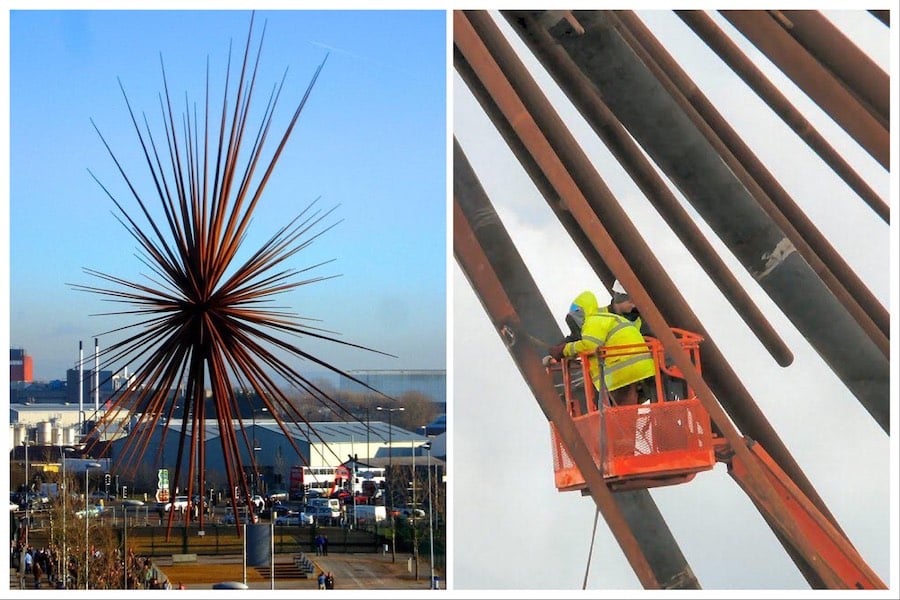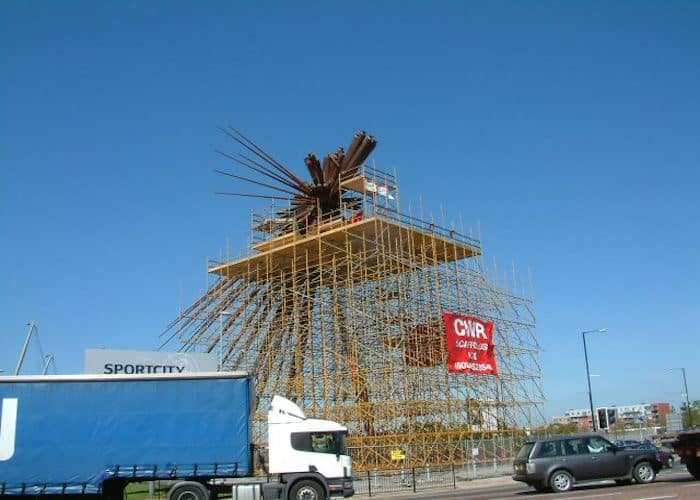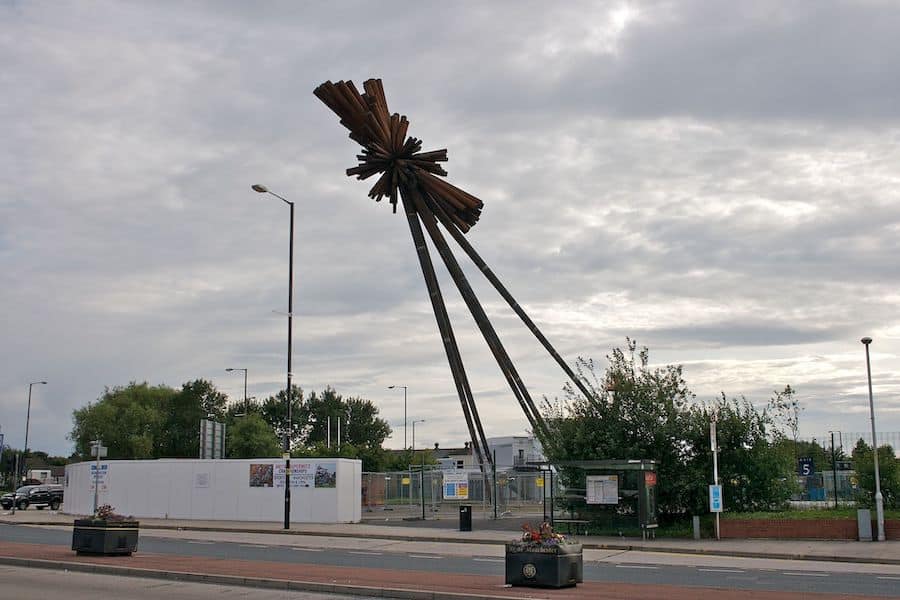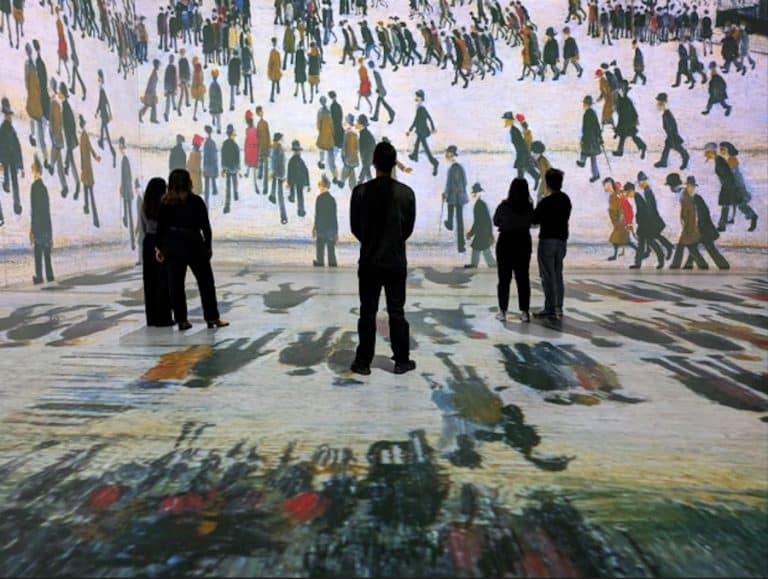The fascinating tale of Manchester’s most ill-fated sculpture
- Written by Thom Bamford
- Last updated 1 year ago
- Cornerstone, History

The B of the Bang has always been a hugely divisive sculpture since it was erected to celebrate Manchester hosting the Commonwealth Games in 2002.
Do you remember what you were up to back in 02? Maybe catching Spiderman at the movies for the first time, or listening to the Eminem Show on CD? Maybe you were sulking to the last episode of FRIENDS.
Anyway, it was a big year for Manchester as the city sat on the precipice of a huge era of regeneration.
So to celebrate, Manchester City Council commissioned a huge sculpture just outside where the Etihad now sits.
Designed to look like a giant exploding firework, by any feat of the imagination it was an incredibly impressive sculpture.
However, its lasting legacy was maybe one of division, argument and polarisation as nearly everyone had an opinion on it. And they weren’t always good ones.
So what do you think? An incredible feat of engineering or architectural eyesore?
We explore the chequered history of the sculpture.

B of the Bang sculpture
Thomas Heatherwick
B of the Bang, a masterpiece by acclaimed artist Thomas Heatherwick, was commissioned to commemorate the 2002 Commonwealth Games.
With its towering presence next to the City of Manchester Stadium, it became one of the city’s tallest structures, proudly holding the title of the UK’s tallest sculpture until 2008.
However, behind its magnificent facade, a tumultuous journey awaited this ambitious artwork.
Linford Christie
The sculpture derived its intriguing name from a famous quote by British sprinter Linford Christie, who stated that his races commenced not at the “bang” of the starting pistol, but at “the B of the Bang.”
This powerful sentiment formed the inspiration for the sculpture’s creation, symbolising the energy and anticipation that precedes a momentous event.
A Manchester City landmark
Bearing a towering height of 56 meters (184 ft), the awe-inspiring B of the Bang sculpture stood as a testament to artistic vision and engineering marvel.
Its imposing structure comprised 180 hollow tapered steel columns, or spikes, emanating from a central core. Positioned at an angle of 30 degrees, this striking artwork derived stability from five tapered steel legs, each stretching an impressive length of 25 meters (82 ft) and connecting to the spikes 22 meters (72 ft) above the ground.
The sheer weight of the sculpture was remarkable, tipping the scales at a staggering 165 tonnes.
Its foundation, composed of reinforced concrete, contributed over 1,000 tonnes to this colossal mass, encompassing a sprawling 400 square meters (4,300 sq ft) of a reinforced concrete slab.
Built to withstand the test of time, B of the Bang employed weathering steel, the same material utilised in the renowned Angel of the North sculpture.
This special steel develops a protective oxide layer as it endures exposure to the elements, effectively reducing corrosion by limiting water permeability.
Notably, the sculpture exhibited a subtle sway in response to the wind, enabling it to withstand gusts surpassing 100 mph (160 km/h).
The overall cost of designing and constructing the sculpture amounted to £1.42 million. Surprisingly, this figure turned out to be twice the original estimate, primarily due to the oversight of installation costs during the initial planning phase.
To bring the ambitious project to fruition, funding was secured from various sources. A substantial contribution of £700,000 came from the European Regional Development Fund, while the North West Development Agency offered a generous sum of £500,000. The remaining £120,000 necessary for completion was provided by Manchester City Council.
This meticulous design consideration ensured the longevity and resilience of B of the Bang, even in the face of Manchester’s tempestuous weather conditions.
During its construction, a significant addition was made to honour the passage of time and inspire future generations.
Concealed within one of the spikes, a time capsule was carefully sealed, containing precious children’s poems and paintings. Intended for unveiling around the year 2300, this captivating glimpse into the past held great significance.
However, following the dismantling of the sculpture, the current whereabouts of this intriguing time capsule remain a mystery, waiting to be discovered once again.
Structural issues B of the Bang
Construction of B of the Bang began in 2003, but the path was far from smooth.
Delays plagued the project, and the official unveiling had to be postponed until 12th January 2005.
Unfortunately, just six days before the highly anticipated event, disaster struck.
A visible structural issue emerged when one of the spikes—180 hollow tapered steel columns radiating from the central core—detached and plummeted to the ground.
Despite this setback, the unveiling proceeded as planned, showcasing the resilience and determination of the artists and organisers.
Regrettably, the challenges persisted.
In May 2005, firefighters were called upon to remove another loose spike, prompting the closure of the sculpture to the public.
Potential solutions?
Manchester residents rallied together, demanding a resolution through a campaign aptly named ‘Get It Sorted.’ Weld defects were discovered within the sculpture, causing cracks during windy conditions.
Various solutions were proposed, including replacing the spikes with heavier steel or utilising carbon/glass fibre composites.
However, the steep costs and aesthetic concerns presented significant hurdles.
During initial assessments, the sculpture’s spikes were found to have weld defects, leading to cracking as they swayed in the gentle breezes of Beswick, Clayton, Ancoats, and Bradford.
To mitigate the issue, weights were attached to the spike tips to dampen violent vibrations. However, the problems persisted as the spikes, despite undergoing wind testing, proved inadequate in strength.
To address the issue, a suggestion was made to use heavier steel, but this solution presented its own challenges. It would have necessitated reducing the size of the spikes, an outcome deemed “unacceptable on aesthetic grounds” in a 2009 council report. Moreover, this alternative would have incurred an additional cost of £3.5 million.
The artist proposed an alternative solution: replacing the steel spikes with carbon/glass fibre composite spikes. These new spikes would incorporate a special feature designed to minimize wind-induced vibrations. However, implementing this option would also require a substantial investment of up to £3 million.
Manchester City Council legal action
In October 2007, Manchester City Council took legal action against the sculpture’s creators, seeking reparations for the structural issues.
Ultimately, an out-of-court settlement was reached in November 2008, with the council receiving £1.7 million in damages for breach of contract and negligence. The resolution marked a turning point in the tumultuous history of B of the Bang.
Dismantling B of the Bang
In the wake of an investigative report published in 2009, Manchester City Council found itself facing a crucial decision regarding the fate of B of the Bang.
The report’s findings led the council to recommend the dismantling of the sculpture and its temporary placement in storage until sufficient funds could be raised to ensure its safe reinstatement.

Recognising its artistic and cultural significance, Manchester City Council pledged to work closely with the artist to find a long-term solution.
While discussions swirled around the future of B of the Bang, voices rose in defence of the monumental artwork.
One notable advocate was esteemed artist Anthony Gormley, who passionately expressed his support, recognising the sculpture as a profound tribute to Manchester.
Gormley urged the preservation of this groundbreaking masterpiece, asserting that its disappearance would not only result in the loss of an inspiring work of art but also signify a retreat from the council’s bold artistic vision.

However, the dismantling process commenced in April 2009, resulting in the central core and legs being cut apart, raising doubts about the sculpture’s future.
With the core eventually sold as scrap for £17,000 in July 2012, uncertainty loomed over the fate of B of the Bang.
However, the spikes found temporary solace in a secret storage location. Although this iconic sculpture no longer graces the Manchester skyline, its legacy endures, reminding us of the city’s ambitious spirit and artistic heritage.
B of the Bang represented more than just a physical structure; it encapsulated Manchester’s boundless creativity and passion. It stood as a testament to the city’s unwavering commitment to the arts and its willingness to take risks. Despite its untimely demise, B of the Bang will for some people hold a special place in their hearts.
Whatever you think about the sculpture. It was a hugely ambitious project. And maybe you miss it just a little?
- This article was last updated 1 year ago.
- It was first published on 14 June 2023 and is subject to be updated from time to time. Please refresh or return to see the latest version.
Did we miss something? Let us know: [email protected]
Want to be the first to receive all the latest news stories, what’s on and events from the heart of Manchester? Sign up here.
Manchester is a successful city, but many people suffer. I Love Manchester helps raise awareness and funds to help improve the lives and prospects of people across Greater Manchester – and we can’t do it without your help. So please support us with what you can so we can continue to spread the love. Thank you in advance!
An email you’ll love. Subscribe to our newsletter to get the latest news stories delivered direct to your inbox.
Got a story worth sharing?
What’s the story? We are all ears when it comes to positive news and inspiring stories. You can send story ideas to [email protected]
While we can’t guarantee to publish everything, we will always consider any enquiry or idea that promotes:
- Independent new openings
- Human interest
- Not-for-profit organisations
- Community Interest Companies (CiCs) and projects
- Charities and charitable initiatives
- Affordability and offers saving people over 20%
For anything else, don’t hesitate to get in touch with us about advertorials (from £350+VAT) and advertising opportunities: [email protected]

Lowry’s most iconic painting becomes a thrilling immersive experience

Five’s first full reunion in 25 years hits Manchester this Autumn



















